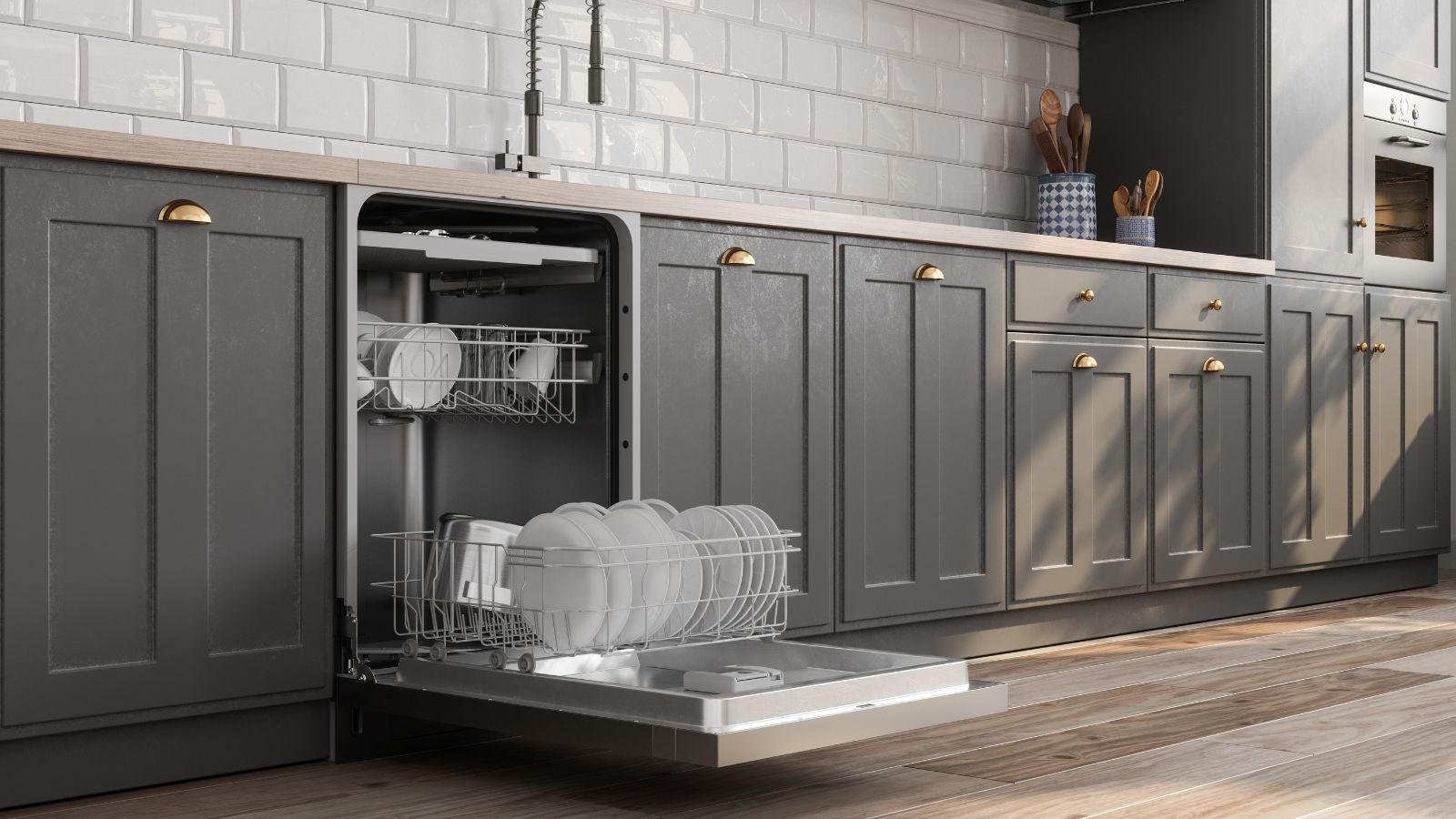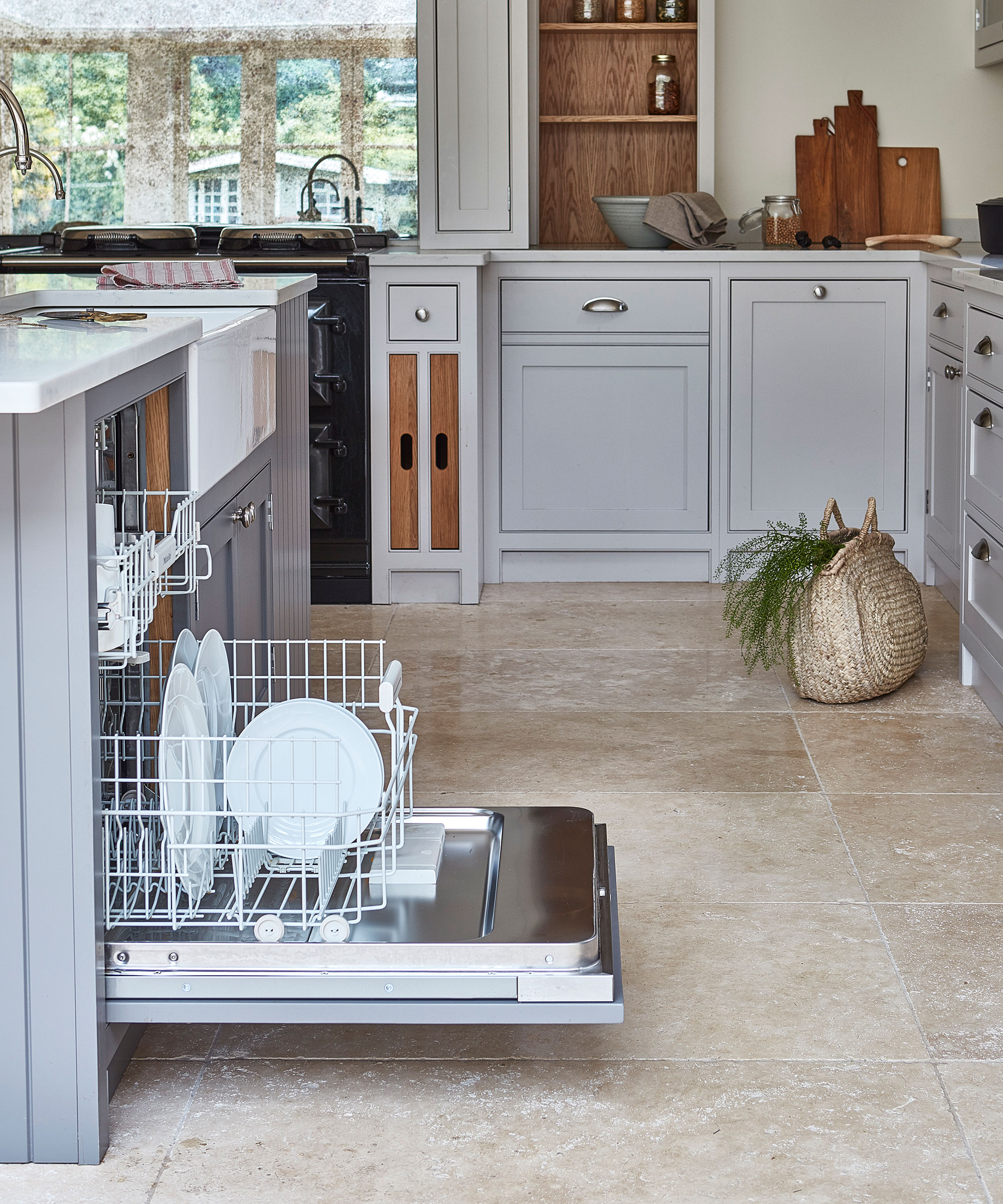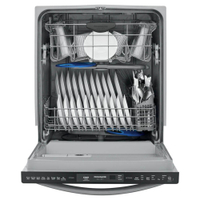The dishwasher mistakes that could be costing you – and how to avoid them
Dishes still coming out dirty? You might be making one of these dishwasher mistakes, experts warn

- 1. Overfilling
- 2. Not scraping dishes first
- 3. Rinsing plates first
- 4. Loading the dishwasher incorrectly
- 5. Blocking the water outlet
- 6. Stuffing utensils together
- 7. Not fully filling the dishwasher
- 8. Not cleaning the filter
- 9. Unloading the top rack first
- 10. Putting the detergent in the wrong place
- 11. Using the wrong detergent, or too much
- 12. Closing the door straight after emptying
- 13. Adding items not safe for dishwashers
- 14. Not reading the manual properly
- 15. Using the wrong setting
- 16. Not optimizing its maximum energy efficiency
- FAQs

A dishwasher is a modern miracle when it comes to efficiency and cutting time on our daily household chores. But many of us are guilty of some common dishwasher mistakes and may not even realize it.
It is commonly thought that the major dishwasher mistakes are investing in the wrong model, not researching the best places to buy appliances first, or not knowing where a dishwasher should be placed. But the most damaging mistakes come after, whether you are loading it incorrectly, or promoting mold growth by leaving the door closed.
Here are the 16 dishwasher mistakes experts say you might be making, and how to correct your errors when loading a dishwasher.
Common dishwasher mistakes
From adding things you should not put in a dishwasher, to not cleaning a dishwasher correctly, these dishwasher mistakes are all simple to fix – there really is no reason to not get your dishwashing routine right.

1. Overfilling
The most common dishwasher mistake is stacking too many dishes in the appliance at one time. ‘Overfilling a dishwasher will not do any damage to the dishwasher,’ begins Ron Shimek, president of Mr. Appliance, a Neighborly company. ‘But, overfilling a dishwasher will not thoroughly clean all dishes, leading to a rewash costing you more time and money.’
‘The easiest way to tell is if you notice your dishes are not coming out as clean as they usually do,’ continues the experts at Sharp Appliances. ‘An overloaded dishwasher cannot successfully get detergent and water to each item, and it cannot successfully drain water away from each item.
‘To prevent overfilling, make sure that each dish, bowl, and cup is occupying its own set of tines, and don’t overload the silverware basket to the point where everything is pressed against each other. It is expected that the water pressure moves the contents of the silverware basket within the compartment, so make sure that you have some wiggle room. Dishwasher manuals almost always come with diagrams and instructions on how to properly load that specific dishwasher,’ they add.
2. Not scraping dishes first
While dishwashers are made to work against a little food build-up on plates and pots, leaving larger clumps of food can lead to a blocked filter or other dirty dishes. ‘While some people may think pre-rinsing dishes is unnecessary, it can actually help prevent food particles from clogging the dishwasher's drain and spray arms,’ says Andrii Gurskyi, co-founder at HomeClean. ‘To fix this, make sure to give dishes a quick scrape into a trashcan before loading them in the dishwasher.’

Andrii is a serial entrepreneur who runs two of the most successful home services companies in the New York and Miami areas, Mr. Glazier and HomeClean.
3. Rinsing plates first
Although scraping plates is always recommended, rinsing them to clean all food residue off entirely is never necessary when loading a dishwasher. Not only is it extra effort, but it could even make your machine less effective as many dishwashers have sensors inside to determine the level of soiling. An abundance of clean plates can lead to a weaker wash and leave some dishes dirtier than others.
‘Not only can pre-rinsing ruin your wash cycle, but it also wastes water and energy,' reveals Christopher Doscher, director of communications at the Association of Homes Appliance Manufacturers.
'People should scrape their dishes and put them directly into the dishwasher. It’s unlikely that you’ll run into a dish that is too dirty for the dishwasher to handle. AHAM’s test procedure for dishwashers uses a mixture of egg yolk, creamed corn, oatmeal, instant mashed potatoes, ground beef, coffee, raspberry preserves, peanut butter, and tomato juice to test a dishwasher's performance. Your dishwasher is up to the task!’
There are some exceptions to this rule, however, add the appliance experts at Sharp Appliances. ‘If your dishes are soiled with acidic foods such as mustard, mayonnaise, vinegar, lemon juice, and tomato-based products, and you are not running the dishwasher immediately, it is best to rinse the dishes. These acid foods may cause discoloration of stainless steel and plastics if they sit for long periods of time.’
4. Loading the dishwasher incorrectly
Loading a dishwasher incorrectly is one of the worst things you can do to your dishwasher.
‘When loading your dishwasher, it is most beneficial to load from the back to the front,’ say appliance experts at Sharp Appliances. ‘Though this doesn’t affect the cleaning of each dish, it helps ensure each dish is loaded in an organized fashion. One mistake to avoid when loading the dishwasher is placing bowls or cups right-side up. This can cause water to gather inside the dish. For best results, place bowls, cups, glasses, and saucepans with soiled surfaces facing down or toward the center. Tilt dishes slightly for better drainage.
‘When loading your drinking glasses in the dishwasher, make sure to place them on the top rack upside down,' as these are one of the things that should always go in the top rack of your dishwasher. 'This helps protect any fragile glasses from being broken or damaged by the more forceful sprayer on the bottom of the dishwasher. For best cleaning results, make sure to tilt the glass slightly for better drainage.’
5. Blocking the water outlet
One of the appeals of using a dishwasher vs washing by hand is the powerful water jets that help to break down tongue burnt marks and grease. Blocking these by incorrectly stacking your dishwasher, however, can make your machine less efficient.
‘You might be tempted to try to fit those few last dishes into the dishwasher, even if it seems full. However, you are better off putting them aside until the next load. Overloading can block jets of water or obstruct the spray arms, resulting in a poor cleaning job,’ explains Christopher Doscher, of the Association of Homes Appliance Manufacturers.
6. Stuffing utensils together
Washing utensils in the dishwasher, especially if you use aluminum foil in the dishwasher, can get them far shiner than washing by hand. However, given their convenient shape for stacking in kitchen organizers, they tend to settle against one another in your machine. The result? They aren't cleaned properly.
‘How you sort your silverware is a personal preference, but we suggest loading the silverware handles up,’ say the experts at Sharp Appliances. ‘This way, you’re lowering the chance of accidentally jabbing yourself with a utensil, preventing them from settling together as easily, and will also reduce the number of times you touch the eating part of the cutlery.
'Some people prefer to use the silverware basket in the bottom tray, dedicating a compartment to each type of utensil. This can make it easier to grab them all at once and put them in the proper space in your drawer.'
7. Not fully filling the dishwasher
When choosing energy-efficient appliances, dishwashers are not always people's first thought. However, when fully loaded, a dishwasher can save a family of four on their water and energy bills every year. A common dishwasher mistake is running the machine while it is still half empty. Not only does this make the appliance far less efficient, but can even result in a less satisfying clean as water runs straight off your crockery rather than bouncing between dishes.
8. Not cleaning the filter
It might not make sense to clean a dishwasher at first. It is an appliance that uses soap and hot water every day, after all. However, built-up grease, grime, and food from dirty dishes quickly contaminate a dishwasher and reduce its efficiency.
‘A dishwasher should be cleaned often. In most cases, weekly cleaning of the screen can be performed,’ says Ron Shimek, president of Mr. Appliance. ‘It is wise to also run a dishwasher cleaner through the machine monthly.’
Cleaning and unclogging a dishwasher is especially important around the dishwasher filter, add the experts at Sharp Appliances. ‘If your dishwasher drains into a food disposal unit, ensure the disposal is completely empty before starting the dishwasher. Not all dishwashers come with user-serviceable or easy-to-access filters for common dishwasher maintenance.
'However, this is the first place I would look if I were on the hunt for unpleasant odors. If your dishwasher does not have easily accessible and serviceable filters and you are still experiencing odor, there are plenty of tips and videos online that may work for you. The solution may be as simple as remembering to refill your rinse aid.
'I also recall the “bowl of white vinegar on the top shelf” tip, although I cannot personally recommend it,' they add. 'One thing I can say is that you should never use any detergent or soap in your dishwasher that was not specifically designed to be used in a dishwasher.’
9. Unloading the top rack first
When unloading a dishwasher, experts suggest starting with the bottom rack first, before moving to the top racks. When unloading a top rack of dishes, you may notice some pooling of water on the tops of mugs or bowls – if you have unloaded the bottom rack first, then this possibly dirty water will not drip all over your freshly washed dishes. Leaving the bottom rack until last, however, will possibly muddy your clean plates and bowls.
10. Putting the detergent in the wrong place
While some dishwasher detergents mention specific locations for placement, most standard detergent pods or blocks should be placed in the detergent compartment of your appliance. Putting tablets at the base of your dishwasher could lead to them dissolving too quickly and the soap not reaching your dishes for a proper and effective clean. The result is some seriously sudsy dishes in one spot, and plainly rinsed dishes in another.
Always check the appliance manual and dishwashing tablet instructions before use.
11. Using the wrong detergent, or too much
Using the wrong detergent entirely is the main cause of a faulty dishwasher cycle, or a dishwasher that's not cleaning properly. ‘Using the wrong detergent or too much detergent can also cause problems, such as a buildup of residue or damage to the dishwasher, warns Andrii Gurskyi, co-founder at HomeClean. ‘Be sure to use the detergent recommended by the manufacturer, and avoid using too much.’
‘It’s important to read the label on all brands of dishwasher detergents. Try a small portion of a new dishwasher detergent before a full load to find the detergent that works best for you,’ suggests Ron Shimek, president of Mr. Appliance.
12. Closing the door straight after emptying
Any appliances that use soap and water are prone to developing mold, especially those with rubber components like door seals. Just like cleaning a washing machine, mold build-up on these seals can be difficult to remove once they have established themselves and can stain – resulting in a disgusting-looking dishwasher.
One of the best ways to help prevent dishwasher mold is by leaving the door open after you have emptied out the dishes. You do not need to leave it fully open so that it is a tripping hazard, but slightly ajar to allow good airflow for the appliance to dry out.
13. Adding items not safe for dishwashers
There are plenty of home cleaning tips that involve using kitchen appliances to clean random household items, such as surprising things you can wash in a washing machine, however, doing this could damage your appliances like the dishwasher.
‘Putting the wrong items in the dishwasher, such as wooden or cast iron utensils, can cause damage to the dishwasher or the items themselves,’ says Andrii Gurskyi, co-founder at HomeClean. ‘Make sure to only put items marked with a dishwasher-safe symbol in the dishwasher.’
14. Not reading the manual properly
‘The biggest and most common mistake that people can make while using their dishwashers is to not read the owner’s manual before using the appliance,’ says Ron Shimek, president of Mr. Appliance. ‘It is important to read the owner’s manual that comes with all your appliances and follows the manufacturer’s instructions.’ Often if you have a problem with your kitchen appliance, the answer is printed there.
15. Using the wrong setting
Dishwashers are, surprisingly, one of the cheapest kitchen appliances to run when used correctly. A big part of this, however, is selecting the right dishwashing setting for each and every cycle.
‘It is generally more efficient to use your dishwasher over hand-washing dishes, even if it isn’t full,’ explains Christopher Doscher, director of communications at the Association of Homes Appliance Manufacturers. ‘Many models allow you to change the setting to half-rack or half-load when you need to wash a smaller load of dishes. Learn your dishwasher’s settings and put them to use.’
16. Not optimizing its maximum energy efficiency
Almost all of us are looking for ways to save money at home, but are failing to optimize our appliances (like dishwashers) to align with our money-saving goals. ‘Look for dishwashers that have the Energy Star certification. These models are designed to work more efficiently and effectively,’ begins Michael Green, chief operating officer at Benjamin Franklin Plumbing.
‘Additionally, no matter how great your dishwasher might be, if it’s too small or compact it won’t get the dishes cleaned as you had hoped. When looking for a dishwasher, consider the size you need for your home and the number of people living in your household. If you’re looking to cut back on the energy used with the dishwasher or if you're sick of unloading the dishwasher and still having to dry every single dish, you can opt to air dry your dishes versus using the heating option. This will save you time and money in the long run,’ he adds.
Frigidaire FGID2468UD Dishwasher | was $829, now $702.54 at Walmart
If you need a new dishwasher, we think the Frigidaire FGID2468UD is a good bet. In full transparency, we haven’t tested this model, but it’s a good balance of energy efficiency and performance. Its energy consumption is excellent — at 268 kWh (kilowatt hours) it’s well below the Fed’s recommended 307 kWh. It’s also Energy Star certified, so it uses 12% less energy and 30% less water than standard dishwashers. This means that the estimated yearly cost of running is just $38. With 8 cycles, including an Energy Saver mode, this is a good choice for energy efficiency.
FAQs
What are the most common faults with a dishwasher?
The most common dishwasher fault is a leaking dishwasher. More often than not, a leaky dishwasher is caused by a simple seal failure. The seal around the door is under constant pressure while the machine is running, and may begin to degrade when exposed to water for years. This should be easily replaced and doesn't require a whole new appliance.
Is it okay to leave clean dishes in a dishwasher overnight?
It is okay to leave clean dishes in a dishwasher overnight if you are too tired to unload the machine the same night. That being said, it is a good idea to wedge the door open a little when doing so to allow excess moisture and steam to escape and prevent mold from developing on the inner seals of your dishwasher.
Sign up to the Homes & Gardens newsletter
Design expertise in your inbox – from inspiring decorating ideas and beautiful celebrity homes to practical gardening advice and shopping round-ups.

Chiana has been at Homes & Gardens for two years and is our resident 'queen' of non-toxic living. She spends most of her time producing content for the Solved section of the website, helping readers get the most out of their homes through clever decluttering, cleaning, and tidying tips. She was named one of Fixr's top home improvement journalists in 2024.
-
 Everyone is obsessed with vintage tiles right now – bring the nostalgic charm of this classic design feature into your home with our 5 design ideas
Everyone is obsessed with vintage tiles right now – bring the nostalgic charm of this classic design feature into your home with our 5 design ideasHonor the past with our favorite ways to decorate with vintage tiles, as suggested by interior design experts
By Eleanor Richardson Published
-
 'It's a fast reset button' – using the 1, 2 ,3 ,4, 5 decluttering method cleared my persistent mess in seconds
'It's a fast reset button' – using the 1, 2 ,3 ,4, 5 decluttering method cleared my persistent mess in secondsIt's easy, effective and so quick to do
By Ottilie Blackhall Published
